
Feature Article
Preparation of Eggs and Egg Products - Safety First
Consuming raw or undercooked eggs can lead to Salmonella infection, which may pose severe and even life-threatening health risks to the patients, especially the susceptible populations. From August 2017 to August 2020, 328 Salmonella food poisoning cases related to food premises (involving 995 victims) were referred by the Centre for Health Protection. To assist the trade in preventing food poisoning caused by Salmonella in eggs and egg products, the Centre for Food Safety (CFS) has published a set of guidelines to provide practical food safety advice on food preparation with eggs. This article provides an outline of the guidelines.
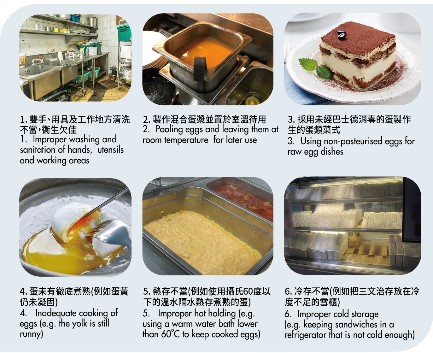
Common high-risk practices of egg preparation in food premises
Choosing Eggs
Choosing safe food ingredients is the first step to ensure food safety. Food businesses should purchase eggs from reliable sources and only accept eggs that are clean and without cracks or leakage. For dishes prepared with lightly cooked or uncooked eggs (e.g. soft-scrambled eggs or tiramisu), it is advisable to use pasteurised eggs, egg products or dried egg powder. Pasteurisation is the process of applying low heat to kill pathogens and deactivate spoilage enzymes.
In some countries, certain shell eggs are produced under certification systems with measures taken at the farm level to reduce the risk of Salmonella contamination. Though claimed to be safe for raw consumption, there are reports that such eggs have been tested positive for Salmonella and have occasionally contributed to foodborne disease outbreaks overseas. Therefore, pasteurised eggs or egg products are still a much safer choice if undercooked eggs are used in food preparation.
Storing and Handling Raw Eggs
Shell eggs should be stored in a cool and dry place (preferably in the refrigerator) and used on a first-in-first-out basis. Improper handling of raw eggs can result in cross-contamination and food poisoning. Food handlers should wash their hands thoroughly before and after handling eggs. They should always clean and sanitise all utensils and other food contact surfaces such as whisks, bowls and working benches before handling eggs and egg products. Washing shell eggs is unnecessary as this will facilitate penetration of bacteria into the egg through pores on the shell. To separate the yolk from the white, a clean egg separator should be used instead of the egg shell, as there may be traces of Salmonella on the surface of the shell.
Pooling Eggs Is a High-risk Practice When Preparing Egg Dishes
Pooling refers to the practice of breaking a number of eggs into a container and using the combined eggs to make multiple servings of egg dishes or as an ingredient for multiple recipes. Pooling of eggs is a common practice in some restaurants to save time and control the portion size. However, if one or more eggs are infected, the whole pool of eggs will be contaminated. If people consume dishes prepared with the contaminated pool of eggs without thorough cooking, they will be at risk of food poisoning. Pooled eggs that are contaminated can also become a reservoir for Salmonella in restaurants as they may contaminate other utensils or foods.
Restaurant staff should break eggs for food preparation only upon receiving orders from consumers. Pooled eggs prepared for later use should be kept in covered containers and placed in the refrigerator. Only the amount needed should be taken out for use. All pooled eggs should be used within the day of pooling. Topping up with new eggs is not suggested. A pool of liquid eggs is more likely to harbour bacteria. It should be cooked thoroughly and should not be used for making raw or partially cooked dishes.
Cook Eggs Thoroughly and Keep Them at a Safe Temperature
The best way to eliminate harmful bacteria is to cook eggs thoroughly until the core temperature reaches 75°C or the yolks are firm. Improper holding temperature of egg dishes is a common cause of local food poisoning outbreaks. If egg dishes are not consumed immediately after preparation, hot foods such as soft-scrambled eggs should always be kept at above 60°C, while cold foods such as sandwiches and desserts should be stored at 4°C or below.
The above advice helps minimise food poisoning risks and applies not only to the food trade, but also home cooking.
Mascot ON in Lesson
How to Keep Food Safe in Case of a Power Cut at Home?
Prolonged power cut is uncommon in Hong Kong nowadays. However, sudden interruption of electricity supply may still occur due to unforeseeable factors such as adverse weather and equipment failure. Power disruption can last for minutes to hours, during which food will spoil rapidly without refrigeration. Power cut can be troublesome, especially when there are a lot of perishable food items in the refrigerator and freezer compartment. Nonetheless, there is no need to panic. The following tips can help you keep food safe while waiting for resumption of power supply.
Keep the Refrigerator and Freezer Shut During Power Cut
To hinder the growth of harmful bacteria and other microorganisms that can cause foodborne illnesses, food in the refrigerator must be kept at 4°C or less while that in the freezer compartment must be kept at -18°C or lower. In case of a power cut, it is best not to open the refrigerator and the freezer compartment. This helps maintain proper storage temperatures for as long as possible and prevent bacteria from growing rapidly within the dangerous temperature zone of 4°C to 60°C.
Overseas food authorities, such as the US Food and Drug Administration and the Food Standards Australia New Zealand, generally accept that if the doors of a refrigerator are kept closed, food will stay safe when stored in the refrigerator compartment for 2 to 4 hours, in a full freezer compartment for 48 hours or in a half-full freezer compartment for 24 hours. Therefore, knowing when the power cut starts is useful in tracking how long the refrigerator and the freezer compartment have been without power. This will help you determine which food items are still safe for consumption.
Follow the “4-Hour/2-Hour Rule” after Resumption of Power
When power is restored, you should check the temperature of perishable food items to find out how long they may have been out of the safe temperature range. For potentially hazardous foods such as meat, seafood, eggs, milk, dairy products, cut fruits and cooked dishes, keep them refrigerated or use them immediately if they have been stored between 4°C and 60°C for less than 2 hours, use them immediately if they have been within this temperature range over 2 hours but less than 4 hours, or toss them away if the duration is more than 4 hours.
Do not check if the food is still good by tasting it because the food may taste or smell just fine. If you are not sure about the safety of easily-spoiled food, simply discard it. Non-perishable food that can be stored at room temperature and is kept in the refrigerator compartment or the freezer compartment may not need to be thrown away in the event of a power cut. High-acid foods (e.g. mustard, ketchup, jams, pickles), certain processed foods (e.g. peanut butter, butter, bread) and most dried foods are typically better preserved than other foods in blackouts.
Prepare for Emergency in Time of Peace
During non-crisis times, we should make sure that the refrigerator compartment is at 4°C or below and the freezer compartment at ‑18°C or colder. It is advisable to place appliance thermometers in both compartments. In addition, always keep some ice cubes and frozen gel packs in the freezer compartment. They can help maintain the temperature by keeping the compartment full and be used to keep foods cold should they be transferred to other places (e.g. friends’ or relatives’ refrigerators).
Throwing away food is a waste of money, but it is better to be safe than sorry as contracting foodborne illnesses may cause severe health consequences or even death. Simply discard the food if you suspect it has deteriorated. It is not worth the risk eating it, especially if young children, the elderly and people with weakened immunity are involved. You should also adhere to the Five Keys to Food Safety during emergencies to protect yourself and the people around you from foodborne diseases.
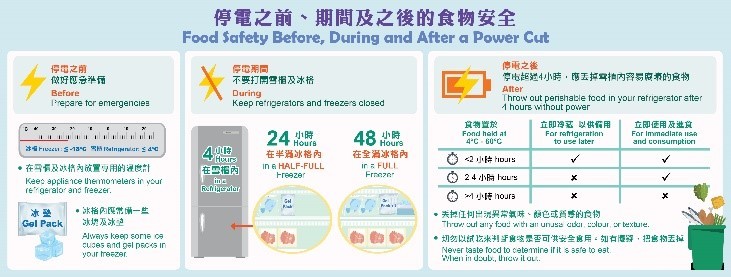
Dining Out
Survey on Providing Consumer Advice on Menus Regarding High-risk Food (Raw Oyster)
(Date: 15-28 June 2022)
When it comes to raw or undercooked foods, raw oyster may be the first thing you have in mind.
Consuming raw or undercooked foods may cause food poisoning as there is inadequate heat treatment to eliminate the microorganisms therein. Such high-risk foods may even carry “superbugs”, which do not necessarily cause illness, but may transfer their antibiotic resistance genes to other bacteria inside the human body, and in turn affect the effectiveness of future use of antibiotics. Susceptible populations including pregnant women, infants, young children, the elderly and people with weakened immunity should be more vigilant and avoid eating these kinds of high-risk foods.
To inform consumers of which food items are served raw or undercooked, food businesses can follow the guidelines issued by the CFS and label those foods on their menus as a reminder to consumers. Apart from menus, consumer advice can also be added on menu boards, signage and food labels, etc.
To enhance the food safety guidelines and facilitate the trade to reduce consumers’ food risk, the CFS conducted a questionnaire survey about the relevant trade guidelines in June to understand how common it is for local restaurants to provide consumer advice on menus regarding high-risk food (raw oyster). The information and data obtained from the survey and visits are intended for internal reference and research purposes only. All information is kept strictly confidential and the names and other details of the participating restaurants will not be disclosed.
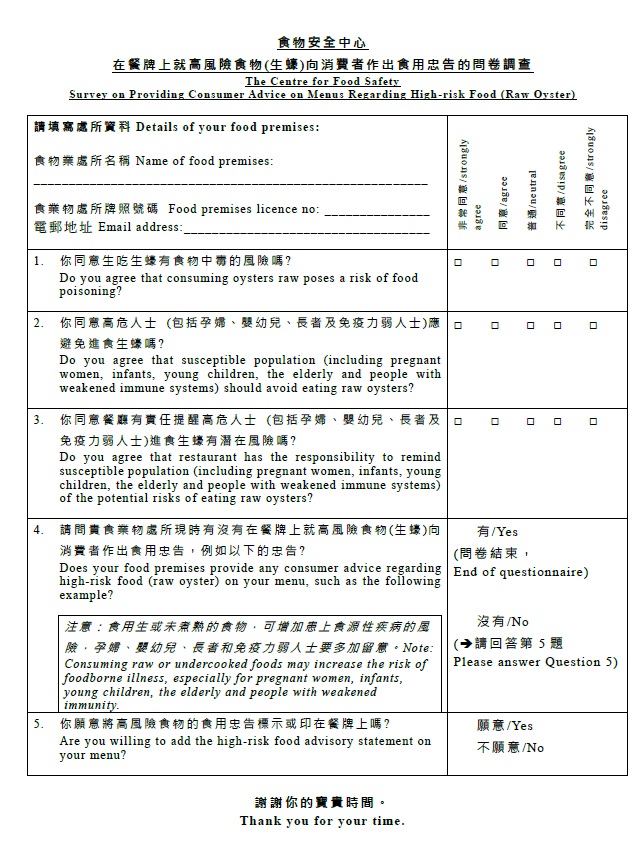
Healthy Eating Basics and Smart Food Choices
Healthy Eating Basics
Facts about Plant-based Milk Alternatives
Plant-based Milk Alternatives (PBMAs) and cow’s milk are rich in nutrients which favour the growth of bacteria to the detriment of food quality and safety during storage. Heat treatments can prolong the shelf life of PBMAs and even impart desirable taste to them. Like cow’s milk, pasteurised PBMAs must be refrigerated, while sterilised products can be stored at ambient temperature. Consumers should be aware that once a PBMA product is opened, the durability will be affected and the storage method should be changed. It should be consumed or refrigerated as soon as possible and stored according to the manufacturer’s instructions.
The composition of PBMAs is very much different from that of cow’s milk. Unfortified soya milk, for example, has one-tenth the calcium content of cow’s milk. Therefore, if PBMAs are used as a substitute for cow’s milk and a primary source of dietary calcium, one should read carefully the calcium amounts on the nutrition labels of the PBMA products. Furthermore, depending on the content of natural and added ingredients, the levels of free sugars and fats in PBMAs vary. Free sugars, including those from cane juice and maple syrup, as well as fats and oils, are often added to PBMAs for better taste and mouthfeel. Those who adopt a strict vegetarian diet should choose PBMAs or cereals fortified with vitamin B12 as a replacement of cow’s milk because no plant-based ingredients can serve as a safe and dependable source of vitamin B12. Finally, since the quality of protein from plant sources is generally considered less optimal than that of meat and milk, vegetarians are advised to consume a variety of nuts, seeds, legumes and soy products for a balanced diet. It is of note that children need sufficient protein and energy for normal growth and development. If PBMAs become a regular part of a growing child’s diet, other food sources of protein and energy are needed to replace those otherwise provided by cow’s milk.
Some people may choose PBMAs due to lactose intolerance or allergy to cow’s milk protein. However, a number of PBMAs may contain allergens that are not present in cow’s milk, such as soybeans, cereals and nuts, which may cause significant reactions in susceptible populations. At the time of purchase, consumers should read carefully the allergen information on food labels to avoid undesirable ingredients.
![]() Tips for Purchase
Tips for Purchase![]()
![]() Read carefully the ingredient list on the package. People with food allergy should avoid allergens.
Read carefully the ingredient list on the package. People with food allergy should avoid allergens.
![]() Refer to the nutrition labels to compare the nutritional content among different products to suit one’s needs.
Refer to the nutrition labels to compare the nutritional content among different products to suit one’s needs.
![]() Children and pregnant women should seek professional advice before replacing cow’s milk with PBMAs.
Children and pregnant women should seek professional advice before replacing cow’s milk with PBMAs.
![]() Tips for Consumption
Tips for Consumption![]()
![]() Follow the storage instructions on the package of PBMAs. Pasteurised PBMAs must be refrigerated, while sterilised products can be stored at ambient temperature.
Follow the storage instructions on the package of PBMAs. Pasteurised PBMAs must be refrigerated, while sterilised products can be stored at ambient temperature.
![]() Once opened, drink up or refrigerate as soon as possible.
Once opened, drink up or refrigerate as soon as possible.
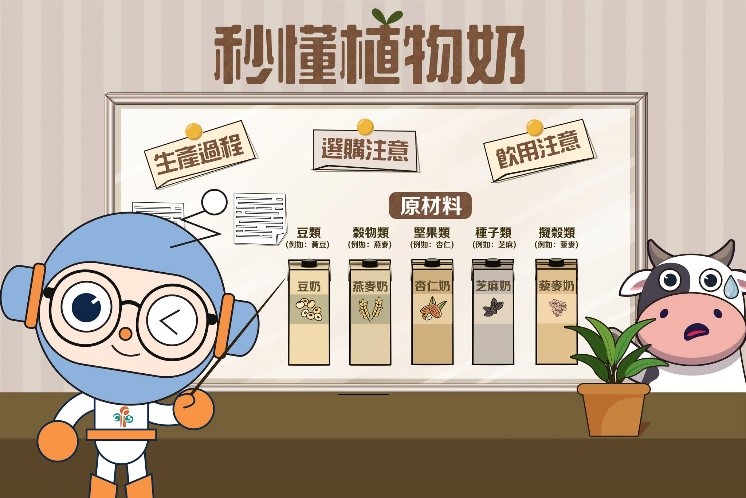
Smart Food Choices
Pan-fried Lean Pork Patties with Lotus Roots
Dining out less often does not mean that you cannot enjoy the finer things in life at home! Why not brighten up life tonight with the delicious “pan-fried lean pork patties with lotus roots”? The dish is low in salt, sugar and oil, and the use of lean pork, in particular, does not only enhance the flavour and texture, but is also healthier! Interested readers may visit the “EatSmart Restaurant Star+” website of the Department of Health
(https://restaurant.eatsmart.gov.hk/eng/content.aspx?content_id=1254) and give this home-style “3 less dish” a try.
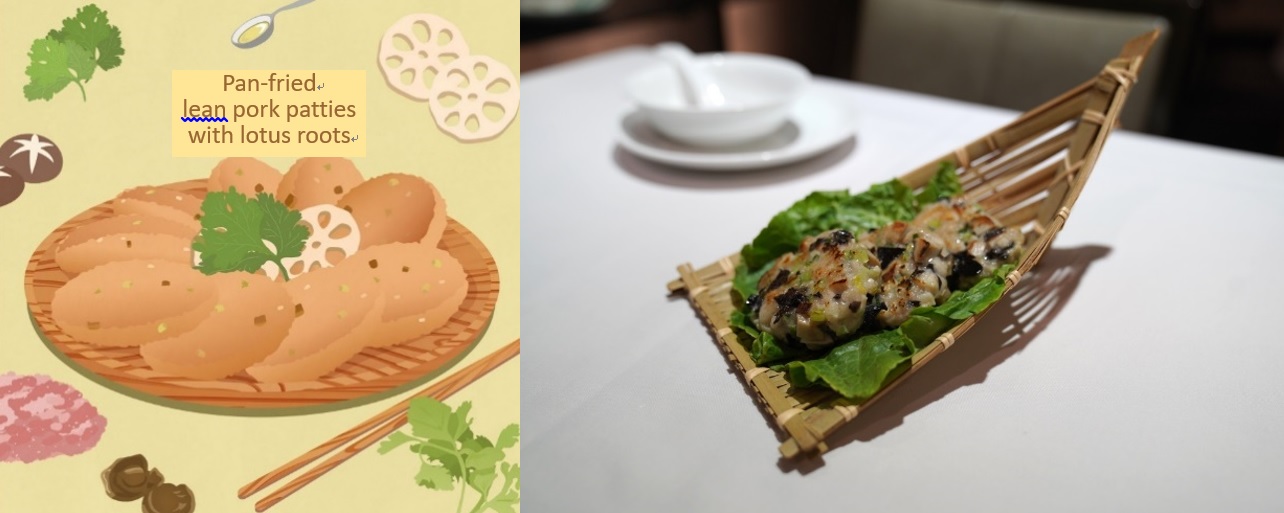

News on CFS
- Promotion of Food Safety Day 2022 by CFS in collaboration with District Health Centres
The year-round Food Safety Day 2022 campaign began on 7 June 2022. To remind the food trade and the public that good hand hygiene is the single most important thing we can do to reduce the spread of infections along the food chain, the CFS will join hands with the District Health Centres (DHCs) to organise health talks, training and educational video broadcast at DHCs across the territory, so as to enhance the awareness and knowledge of the public on observing hand hygiene while handing food.
Publicity leaflets and pamphlets on hand hygiene will be made available to the public for collection at the DHCs in batches.
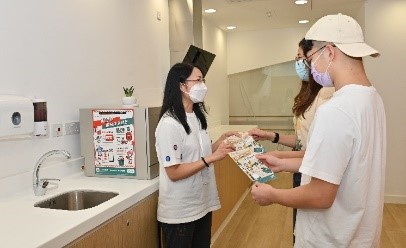
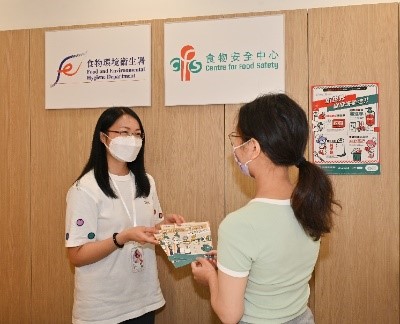
- CFS New Broadcast Van Now in Service
The CFS’s new broadcast van, decorated with cartoons on its body to promote food safety and hygiene messages, is now in service. The van is equipped with a large television screen for showing videos produced by the CFS to improve visitors’ understanding of the Five Keys to Food Safety.
Adopting a lively design, the van aims to promote in an easy-to-understand manner the Five Keys to Food Safety, which include:
- Choose - choose safe raw materials;
- Clean - keep hands and utensils clean;
- Separate - handle raw and cooked food separately;
- Cook - cook food thoroughly to ensure that the core temperature reaches at least 75°C; and
- Safe temperature - keep hot food at above 60°C and cold food at 4°C or below if it is not consumed immediately.
Members of the public are welcome to watch some fun-filled videos about food safety played on the van if they see it nearby. Those who would like to receive the latest activity updates or food/allergy alerts of the CFS may scan the QR code displayed on the van.



-


- Release of Findings of Changes in Nitrite Levels of Cooked Vegetables after Storage
On 24 June 2022, the CFS held a press conference through online video conferencing for the first time to reduce gatherings and maintain social distancing in light of the pandemic. At the conference, Dr CHEUNG Yung-yan, Terence, Principal Medical Officer (Risk Assessment & Communication), released the findings of a study on the changes in nitrite contents of cooked vegetables after storage. According to the findings, nitrite was not detected in the cooked vegetable samples which had been stored in the refrigerator overnight.
In view of allegations of rapid increase of nitrite contents in cooked vegetables after overnight storage in the refrigerator, the CFS collected samples of five commonly consumed vegetables (amaranth, pak choi, flowering white cabbage, Chinese lettuce and zucchini) at retail outlets for study. The nitrite contents of the samples were measured before and after cooking. The results showed that the nitrite contents did not increase after the cooked vegetables had been stored in the refrigerator overnight and remained low after storing for three days. Storage temperature is the main factor that affects the rate of increase of nitrite content in cooked vegetables. Refrigerated temperature inactivates bacteria and delays nitrite formation.
Fresh vegetables absorb nitrate from the soil to produce proteins for growth. Nitrate in cooked vegetables can be converted to nitrite by the bacteria in the environment. Nitrite may lower the ability of blood to carry oxygen. It may also produce nitrosamines, chemicals that cause cancer in animals, in the body. Currently available scientific evidence, however, does not suggest that nitrate and nitrite intake from diet is associated with cancer risk in humans. The World Health Organization recommends eating five servings of vegetables and fruits per day to stay healthy and minimise the risk of non-communicable diseases (NCDs). Vegetables contain antioxidants, phytochemicals, vitamins, minerals, dietary fibre and plant proteins. These compounds can act synergistically to prevent or slow down the onset of some NCDs.
Some spoilage bacteria can still grow at refrigerated temperature and spoil food even though most harmful bacteria cannot. Members of the public should take heed of the following recommendations to ensure the safety of leftover food (including cooked vegetables):
- Prepare a suitable amount of food to reduce leftovers;
- Leftovers should be refrigerated within two hours after cooking and consumed as soon as possible;
- Before consumption, reheat leftovers thoroughly until the core temperature reaches 75o Leftovers should not be reheated more than once; and
- Do not consume leftovers if they have been placed at room temperature for more than four hours.
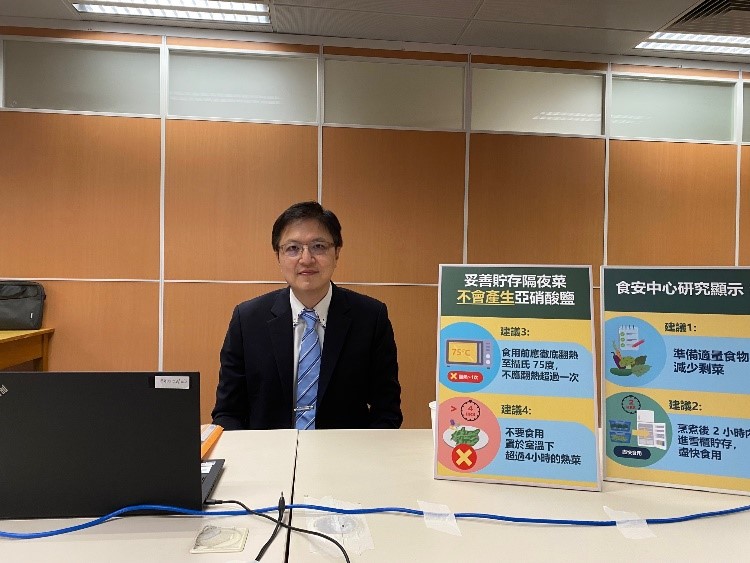
Ask Our Mascots
Latest Report on Sodium Content of Dim Sum (With Practical Tips to Reduce Sodium Intake)
#Mascot ON: Among the many different types of dim sum, do you know which one is the highest in sodium (salt)? How can we cut down on sodium intake from dim sum? Let’s take a look at the latest CFS report on the sodium content of dim sum!
The CFS collected samples of 12 types of dim sum and 4 types of sauces from more than 50 Chinese restaurants and dim sum shops for sodium content analysis. The results showed that:
- some samples of shrimp siu mai and spring roll with shrimp were considered high in sodium (i.e. over 600mg per 100g of food)
- some samples of rice roll were considered low in sodium (i.e. not more than 120mg per 100g of food)
- consumption of dim sum with sauces served might increase the sodium content by more than two times
The top three types of dim sum with the highest sodium content (per 100g of food) were:
- shrimp siu mai (590mg)
- spring roll with shrimp (480mg)
- steamed minced beef ball (440mg)
#CFSTeam: We have prepared some tips for you to reduce sodium intake from dim sum:
- Be aware that the sodium content of certain types of dim sum is higher. Choose carefully and maintain a balanced diet with variety.
- Request the dim sum to be served separately from sauces.
- Taste before dipping in sauces; if needed, dip lightly in the sauces.
- Read the nutrition labels when buying prepackaged dim sum and choose those products with lower sodium content.
#Mascot MUI: There is a decreasing trend in the sodium content of some dim sum samples as compared with the results of previous studies, revealing the possibility for the trade to reduce the sodium content in dim sum. The trade may refer to relevant CFS guidelines and provide consumers with healthier choices through modification of preparation methods and ingredients.
For more details about the report, please visit:
https://www.cfs.gov.hk/english/programme/programme_rafs/programme_rafs_n_01_31_Sodium_content_in_dim_sum.html

Food Safety Quiz
- Which of the following is a correct way to handle eggs or egg products?
- Wash the shell thoroughly with clean water before storing the eggs
- Cook the eggs thoroughly until the core temperature reaches 75°C or the yolks are firm
- Keep sandwiches and desserts with egg ingredients at room temperature
- Which of the following is not a correct way to handle foods in the refrigerator in case of a power cut?
- Open the refrigerator and the freezer immediately
- Pay attention to when the power cut starts
- Refrain from tasting foods to determine if they are safe to eat after a power cut of more than 4 hours
- Which of the following groups of individuals should avoid raw or undercooked foods?
- Infants
- Pregnant women
- People with weakened immunity
- All of the above
Answers:
1. B 2. A 3. D
Diary of Mascot ON
Insight from a Meat Cutter

Mrs CHU: Hey, are you AhOn? You look so cool and cute in person!
AhOn: Hello, do you want to buy some pork?
Mrs CHU: Well… can I take a photo with you?
AhOn: Photo? Sure, but before that, please allow me to share with you some food safety tips on handling raw meat at home.
First of all, keeping the hands clean is crucial when handling foods. Wash your hands with clean water and liquid soup and rub the hands for at least 20 seconds:
![]()
![]() after grocery shopping;
after grocery shopping;![]()
![]() before and after handling raw meat;
before and after handling raw meat;![]()
![]() before putting on and after removing gloves;
before putting on and after removing gloves;![]()
![]() after going to the toilet; or
after going to the toilet; or![]()
![]() before eating.
before eating.
If you have any wound on your hands, cover it properly with a waterproof bandage and put on protective gloves before handling raw meat to prevent Streptococcus suis or Group B Streptococcus infection!
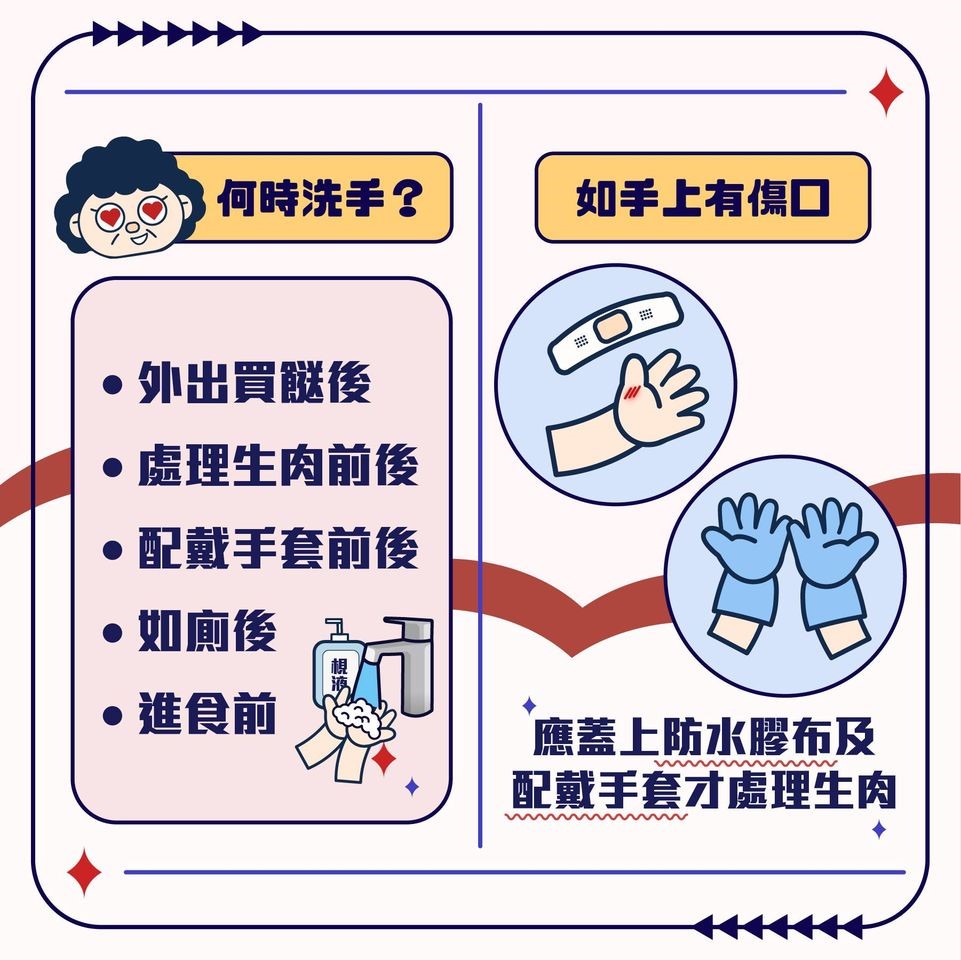
Besides, one should use different utensils (like knives and cutting boards) for raw and cooked ingredients to prevent cross-contamination. Finally, we must make sure that the meat is thoroughly cooked before serving! Now, say cheese, yeah![]() !
!
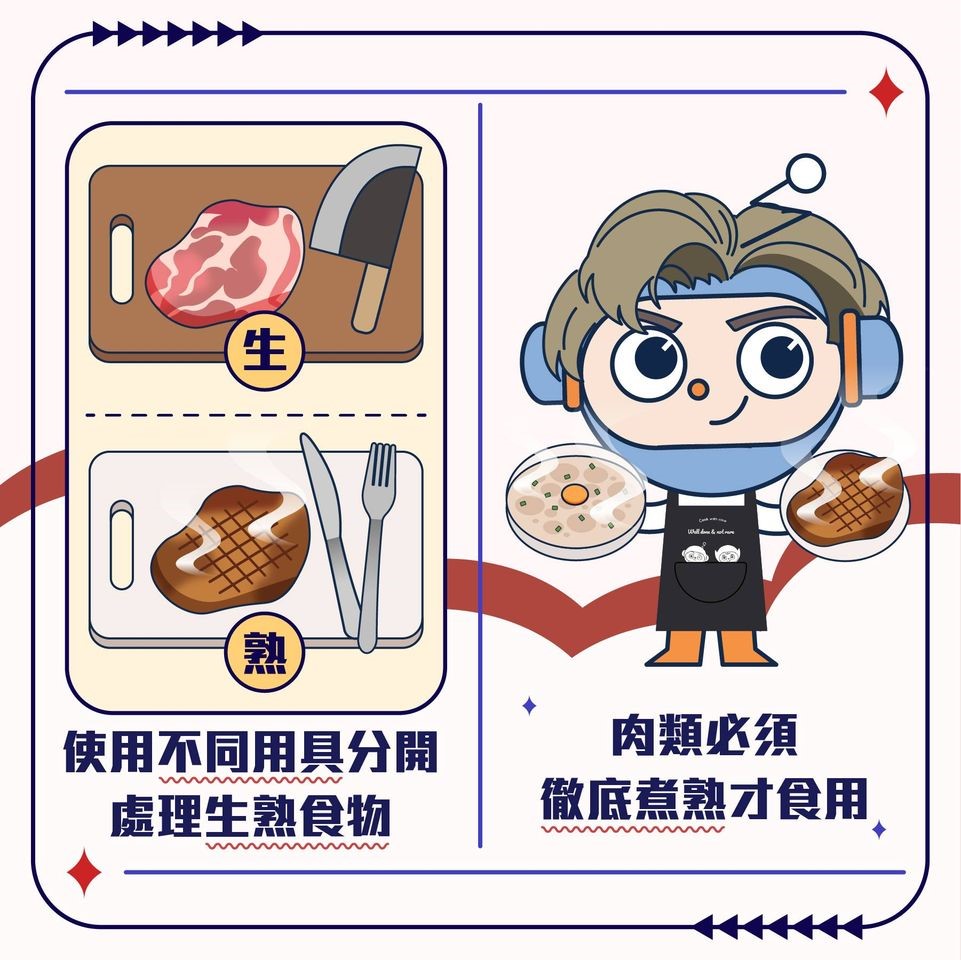
Mrs Chu: ![]()
![]()
![]()